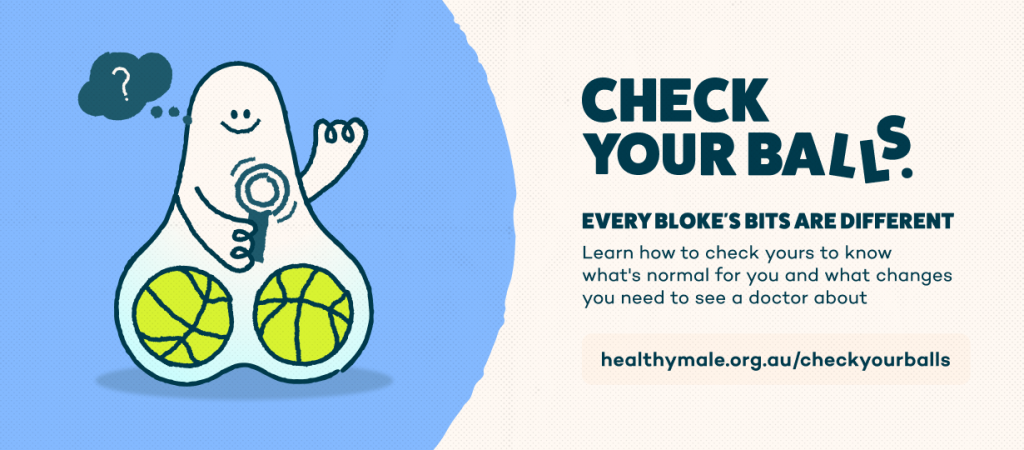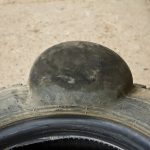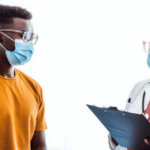Any changes to the size and shape of your family jewels deserve close attention, so if you’re experiencing swollen testicles it’s best to get to the bottom of it ASAP. Whether it’s the result of a kick in the crotch or testicular cancer, a chat with your doctor will help you determine the cause. But to get you up to speed, we’re covering the most common causes of swelling in this area and how to keep tabs on your testicular health.
If you experience sudden, severe pain in your testicles
Seek immediate medical help. This could be a sign of testicular torsion. Testicular torsion happens when a testicle twists in the scrotum, cutting off the blood supply and causing swelling. Unless the condition is treated quickly, the testicle can die. Call 000 or head to your nearest hospital straight away.
A quick anatomy explainer… what are testicles?
The testes — also known as testicles — are important parts of the male reproductive system. They’re a pair of oval-shaped glands responsible for making sperm and testosterone. Your testes sit inside your scrotum, which is the sac of skin that hangs under the base of your penis, so your testes are kept outside of your abdomen.
You might refer to your scrotum and its contents as your balls. In this sense, swollen balls could be due to swelling in one or both of your testes or it could be swelling in other parts of your scrotum and its contents, such as the epididymis (a coiled tube that lies at the back of each testicle) or the vas deferens (the tube that connects your epididymis to your urinary tract).
Why is one ball bigger than the other?
It’s common and normal for one testicle to be slightly larger than the other. This natural asymmetry occurs in many healthy males and is typically not a cause for concern. The right testicle is usually busier than the left. It’s just a natural part of anatomy.
What causes swollen testicles?
There are a couple of reasons why your testes may be swollen, some more critical than others. This point isn’t to make you panic but to encourage you not to sweep the issue under the rug in the hope it will clear up on its own.
Can testicle inflammation go away on its own?
Sometimes but if your swollen testicle hasn’t gone away after a few days it’s important to see a doctor.
Common causes of testicular swelling
Infection
Orchitis is inflammation of one testis or both testes and is usually caused by either bacterial or viral infection.
Mumps is the most common cause of orchitis.
Orchitis rarely occurs on its own. Usually inflammation of the epididymis (epididymitis) occurs at the same time, resulting in epidiymo-orchitis. Bacterial infections are the most common causes of epididymitis and epididymo-orchitis.
Testicular torsion
Testicular torsion occurs when the testis rotates inside the scrotum twisting the spermatic cord, which can cut off blood flow to the testicle. It causes sudden and severe testicular pain, and swelling in the scrotum or lower abdomen, and can also be accompanied by nausea and vomiting, discoloration of the scrotum, strange positioning of the testicle, and difficulty walking.
It’s not always clear what causes testicular torsion but it most frequently occurs during sleep, after an injury to the area, and within hours of intense activity. The condition requires immediate medical attention and the longer treatment is delayed, the more likely you’ll have permanent damage to the testicle.
Testicular cancer
The most common symptom of testicular cancer is a painless lump or swelling in one of the testis. Other symptoms include a feeling of heaviness in the scrotum, and a change in size or shape of your testes. If the cancer has spread, symptoms could also include backaches, coughing or breathlessness, and enlarged, tender nipples.
Testicular cancer is the second most common cancer affecting young Australian men but it’s curable in 95% of cases. It’s important to find it early, which is why you should regularly check your testes and see a doctor about any swelling or other changes.
What causes swelling in your scrotum and its other contents?
Scrotal swelling and inflammation in the other structures within your scrotum are also important to address with your doctor.
Common causes of swollen balls
Injury
Unlike other organs, testes don’t have muscles or bones to protect them making them more susceptible to injury. As many people know all too well, getting kicked, crushed, or struck below the belt can cause substantial pain as well as swelling. Trauma to the scrotum can sometimes cause a haematocele (a collection of blood).
Epididymis
Epididymitis is a painful swelling or inflammation that occurs on the epididymis — a thin, coiled tube connected to the testes, within the scrotum. It may be caused by a bacterial or viral infection such as a sexually transmitted infection or a urinary tract infection. It may also occur due to friction against a surface like a bike seat or a saddle.
Hydrocele
A hydrocele is a fluid-filled sac that forms around the testis and can cause swelling. If you’re older, this is the most common cause of swelling around the testes, although it can happen at any age and sometimes follows injury or inflammation. Hydroceles are usually painless but can increase in size and cause discomfort, requiring treatment.
Varicocele
A varicocele is a swelling of the veins above your testes. It’s relatively common, and usually happens on the left side of the scrotum.
Inguinal hernia
A hernia is when part of an organ or tissue passes from its normal location into another part of the body.
An inguinal hernia is when a part of your intestine pushes through a weak spot in your groin, into your scrotum. You’ll likely feel swelling around your scrotum, dull ache or pressure, or pain when you cough, bend or lift something heavy. This is most common in newborns or young boys, but it may also affect men later in life if they are engaged in strenuous activity such as powerlifting.
Testicular self-examination
Getting familiar with the look and feel of your genitals is really important for your health so when something is amiss, you notice it and can get it sorted ASAP. Get in the habit of regularly giving yourself a testicular self-examination (sometimes called a TSE).















